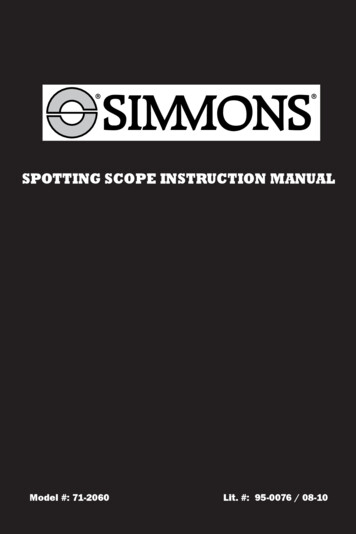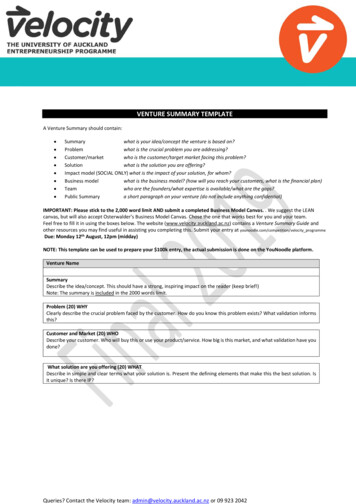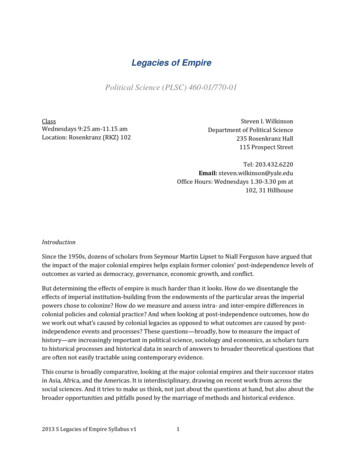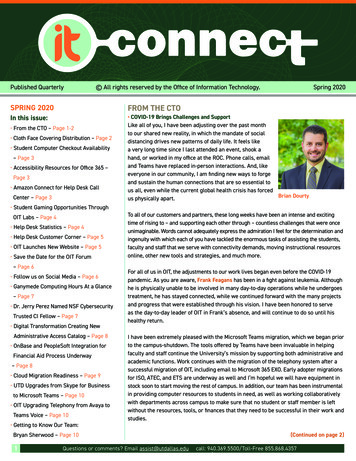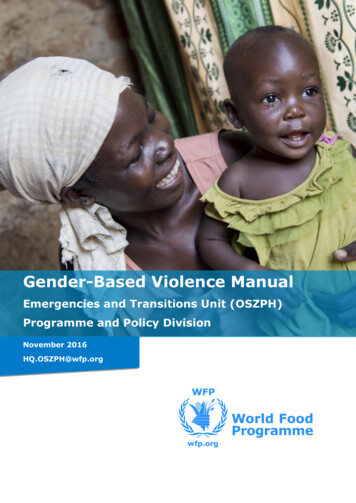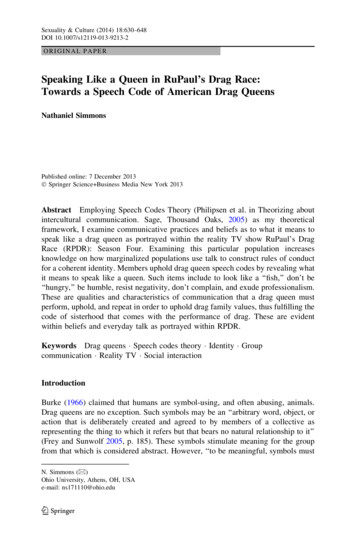
Transcription
Sexuality & Culture (2014) 18:630–648DOI 10.1007/s12119-013-9213-2ORIGINAL PAPERSpeaking Like a Queen in RuPaul’s Drag Race:Towards a Speech Code of American Drag QueensNathaniel SimmonsPublished online: 7 December 2013 Springer Science Business Media New York 2013Abstract Employing Speech Codes Theory (Philipsen et al. in Theorizing aboutintercultural communication. Sage, Thousand Oaks, 2005) as my theoreticalframework, I examine communicative practices and beliefs as to what it means tospeak like a drag queen as portrayed within the reality TV show RuPaul’s DragRace (RPDR): Season Four. Examining this particular population increasesknowledge on how marginalized populations use talk to construct rules of conductfor a coherent identity. Members uphold drag queen speech codes by revealing whatit means to speak like a queen. Such items include to look like a ‘‘fish,’’ don’t be‘‘hungry,’’ be humble, resist negativity, don’t complain, and exude professionalism.These are qualities and characteristics of communication that a drag queen mustperform, uphold, and repeat in order to uphold drag family values, thus fulfilling thecode of sisterhood that comes with the performance of drag. These are evidentwithin beliefs and everyday talk as portrayed within RPDR.Keywords Drag queens Speech codes theory Identity Groupcommunication Reality TV Social interactionIntroductionBurke (1966) claimed that humans are symbol-using, and often abusing, animals.Drag queens are no exception. Such symbols may be an ‘‘arbitrary word, object, oraction that is deliberately created and agreed to by members of a collective asrepresenting the thing to which it refers but that bears no natural relationship to it’’(Frey and Sunwolf 2005, p. 185). These symbols stimulate meaning for the groupfrom that which is considered abstract. However, ‘‘to be meaningful, symbols mustN. Simmons (&)Ohio University, Athens, OH, USAe-mail: ns171110@ohio.edu123
Speaking Like a Queen in RuPaul’s Drag Race631be interpreted by members in a relatively similar manner’’ (Frey and Sunwolf 2005,p. 186). In other words, cultural groups construct, reinforce, and perpetuate culturalvalues about speaking (Philipsen 1975, 1976). Taking a symbolic interpretiveperspective (Frey and Sunwolf 2005) offers insight into how members co-constructa group identity via cultural norms for speaking. Thus, the purpose of this study is tobegin initial exploration into particular ways of speaking for American drag queensas portrayed within RuPaul’s Drag Race: Season Four. Doing so will provideunderstanding into the meaning behind drag queen verbal communication. First, Iwill discuss how drag queens use communication to construct a unique groupidentity. Second, I contextualize RuPaul’s Drag Race. Third, I discuss how SpeechCodes Theory (Philipsen et al. 2005) serves as an appropriate theoretical lens forthis study. Finally, I share my analysis and interpretations.Drag Queens, Communication, and Group IdentityMarginalized groups such as drag queens have unique ways of using language tocreate a shared reality. The presentation of the gendered self is performative innature by communicating physical and sartorial messages and, thus, particular waysof speaking (Butler 1990). Barrett’s (1994, 1995a, b, 1997, 1998) seminal researchrevealed drag queens as a unique speech community. Since language is a vitalcultural artifact, it is crucial to gain understanding into ways in which drag queensuse language (Mann 2011). Drag queen language has offered insight into culturalideologies regarding gender, sexuality, and race (Mann 2011). However, Mann(2011) did not focus explicitly upon how these ideologies are expressed in talk.Drag queen research has predominately focused upon issues related to gender(Taylor and Rupp 2004, 2005; Schacht 2004; Rupp et al. 2010; Friedman and Jones2011), race (Mann 2011), performance (Moreman and McIntosh 2010), and internalgay community segregation (Berkowitz et al. 2007) or marginalization (Berkowitzand Belgrave 2010; Brookey and Westerfelhaus 2001). Such research identified thatdrag queens have culturally unique ways of speaking. In particular, it reveals dragqueens use nonverbal aesthetics to communicate a coherent drag identity as queensblur gender lines and use performance as a space in which to bend the dominantAmerican gender narrative binary.Within the larger LGBTQ community, drag queens have not only served asiconic forms of entertainment, but maintain a strong historical stance ofcommunicative actions for social justice. Drag queens have been credited withthe start of the Stonewall Riots in 1969 which ignited the Gay Liberation Movement(Zervigon 2009). However, despite their historical role drag queens oftenexperience marginalization throughout the queer community. Drag queens experience double-stigmatization as many drag queens are constituted as part of thelarger gay male community as well as the gender-blending community whichcontains heterosexual cross-dressers (Newton 1972; Tewksbury 1994; Berkowitzet al. 2007). Such stigmatization is present within romantic relationship difficultyamongst drag queens such as having dating options (Berkowitz et al. 2007), as wellas how the gay community has constructed drag queens as ‘‘the jester’’ of the gaycommunity in which drag queens exist to perform and entertain, thus deemed only123
632N. Simmonsappropriate for the stage (Namaste 2000). Communication scholars have revealedvested interest within stigma and identity-related research within various marginalized populations such as gay Asian men (Eguchi 2011), sex workers (Basu 2011),and the homeless (Harter et al. 2005). Examining ways in which drag queens createshared meaning via speech codes will contribute to the larger body of literatureregarding ways in which stigmatized groups construct a coherent, collectiveidentity. Frey and Sunwolf (2005) argue ‘‘Group actions often create uniquesymbols that bind members together into a group’’ (p. 215). Understanding thediscursive symbols a community uses, scholars may begin to understand howcollective identity for drag queens is constructed.Individuals are reflections of interacting units (Mead 1934). Barnlund (1988) said‘‘every culture attempts to create a ‘universe of discourse’ for its members, a way inwhich people can interpret their experience and convey it to one another’’ (p. 11).Throughout interaction, groups symbolically communicate shared meaning andidentity. It is throughout this process that people learn how to encode and decodesymbolic meanings that create space for individualized, group expression (Mead1934; Blumer 1969, Stryker 1980). Stryker (1980) claims that identity not onlyrefers to who or what one is, but also refers to a variety of traits and meaningsattached to one’s self by others as well as those that we attach to ourselves. Mead(1934) offers that identities help people to frame interaction as well as to defineinteraction by supplying shared meanings. It is my intent to begin a scholarlydiscussion and research agenda to understand what it means to speak like a dragqueen. One way to seek this insight and understanding is via the reality televisionshow RuPaul’s Drag Race.RuPaul’s Drag Race and Reality TVRuPaul’s Drag Race (RPDR) is the first reality television show featuring dragqueens (Shumaker and Slane 2011a). The season four premiere of RPDR, and thetarget season of this study, was the number one rated premiere in cable channelLogo’s history (Shumaker 2012, February 1). Thirteen contestants from across theUnited States and Puerto Rico compete through various challenges which testperformance, fashion sense, humor, intellectual ability, teamwork, and timemanagement. Contestants compete both individually and through team challengesfor immunity from elimination. However, in the end, only one will demonstrate thecharisma, uniqueness, nerve, and talent (CUNT) RuPaul claims is needed to win thetitle of ‘‘America’s Next Drag Superstar’’ (ANDS) which results in a prize packageincluding 100,000, a unique trip from AlandChuck.travel, a lifetime supply ofNYX Cosmetics, and a spot headlining Logo’s Drag Race Tour (Shumaker andSlane 2011a). RPDR has been defined as ‘‘men dressed as brazen caricatures offemininity parading themselves in front of celebrity judges of varying degrees ofrelevance in a competition that crosses America’s Next Top Model with To WongFoo, Thanks for Everything, Julie Numar’’ (Navarro 2012, April 23).The tough competition of reality TV offers a visible explanation of whatanthropologist Hogan (1975) explained; human ‘‘survival was promoted by thequality of the group rather than the accomplishments of individuals’’ (p. 537). I123
Speaking Like a Queen in RuPaul’s Drag Race633recognize that ‘‘group’’ may apply unevenly to reality TV shows, but I believe thatscholars can recognize this specific reality TV show as containing groups sinceindividuals are working toward a common goal. By analyzing reality TV shows,group scholars can understand how specific communities construct an identitythrough language. RuPaul’s Drag Race (RPDR) features individuals who, althoughcompeting, are working towards a common goal and maintain a sense of sharedidentity as illustrated throughout the show by comments such as ‘‘we are sisters’’ or‘‘this is like a drag sorority.’’I realize that the editing and production process of making TV that ‘‘sells,’’ limitsthe naturalistic inquiry of this specific group. ‘‘Reality’’ as represented via realityTV is a product of production choices to mold and ‘‘choreograph the content intoengaging and identifiable viewing for audiences’’ (Price 2010, p. 452). Suchconstructions utilize various documentary techniques such as ‘‘‘fly-on-the-wall’recording, talking-head interviews and omniscient voiceover’’ (p. 452). RPDR is noexception. These techniques are combined with entertainment practices such as‘‘multiple narrative strands, evocative soundtrack and slick editing’’ (p. 452). Thus,reality TV is defined as a place in which a producer is able to construct, change, and/or impose a message(s) onto its audience through various documentary techniquescombined with entertainment practices (Price 2010). Thus, reality TV is purposely‘‘mixed’’ to contain humor, drama, human interest, and character (Price 2010).Regardless of ‘‘mixing,’’ member talk is still exonerated and placed first whichprovides space for analysis.After each episode of RPDR, viewers may watch a brief 20 min episode ofUntucked. Untucked contains footage of ‘‘backstabbing, backbreaking, backstagedrama that you didn’t see on the runway’’ (Shumaker and Slane 2011b). Untuckedtakes place within the Interior Illusions Lounge where contestants go to await thejudges’ critique and RuPaul’s decision as to who will be in the ‘‘bottom two.’’ Thetwo worst contestants, or the bottom two, are forced to ‘‘lip synch for their life’’ fora chance to stay within the competition.By using episodes from various reality TV shows as a means of data collection,researchers uncovered that reality TV has been found to: reinforce Australianidentity constructions (Price 2010); perpetuate gender and class norm masternarratives (Franco 2008); couple immoral conduct with pleasurable emotions(Krijnen and Tan 2009); and advance understanding of how narrative responsesallow participants to accomplish identity work (Gordon 2011). Via workroom,backstage, and runway performances, RPDR can serve as a lens in which to solicitand explore culturally specific ways of speaking throughout everyday language ofdrag queens. Thus, speech codes theory (Philipsen et al. 2005) will serve as theunderlying theoretical lens for this study.Speech Codes TheoryGrounded within Hymes (1967, 1968, 1974) ethnography of speaking, speechcodes theory (SCT) is well suited to explore ways in which what particularcommunication (de)constitutes collective drag queen group identity within123
634N. SimmonsRuPaul’s Drag Race. SCT is appropriate because (a) it is grounded in observationof communicative conduct within a particular time and space; (b) provides a wayto interpret observed communicative conduct; and (c) provides a generalunderstanding of ways in which contestants conduct themselves via communication (Philipsen et al. 2005). SCT is based off of six propositions, which include:(a) within any distinct culture, distinct speech codes exist; (b) multiple speechcodes are deployed within any speech community; (c) distinct cultural psychology,sociology, and rhetoric are implied within speech codes; (d) speaking significanceis based off ways in which interlocutors create meanings of communicative acts;(e) the act of speaking a speech code indicates the terms, rules, and premises of aspeech code; (f) intelligibility, prudence, and morality of communicative conductmay be predicted, explained, or controlled by the artful uses of shared speechcodes.SCT has been used to investigate culturally distinct ways of speaking in a widerange of communities. Within the United States, scholars have identified diverse,yet distinctive codes such as upholding the code of honor by speaking like a man(Philipsen 1975, 1976), the code of listening amongst Blackfeet Indian talk(Carbaugh 1999, 2005), the code of dignity as evident within Nacirema’s sit downand talk ritual (Katriel and Philipsen 1981), the code of food and tradition in relationto Lebanese-American identity (Homsey and Sandel 2012), and Ward’s (2010)study revealed the role of symbolic action amongst fundamentalist Christians during‘‘I was saved’’ testimonials. Each of these studies reinforce Philipsen’s (1997) claimthat distinct cultural codes exist wherever there is a culture.Drawing upon SCT, I seek to explore whether I can identify aspects of a distinctspeech code for American drag queens. If so, I seek to understand whatcharacteristics are present within said code(s) and how it is transmitted. Therefore,I am interested in understanding meanings associat
appropriate for the stage (Namaste 2000). Communication scholars have revealed vested interest within stigma and identity-related research within various margin-alized populations such as gay Asian men (Eguchi 2011), sex workers (Basu 2011), and the homeless (Harter et al. 2005). Examining ways in which drag queens create shared meaning via speech codes will contribute to the larger body of li
